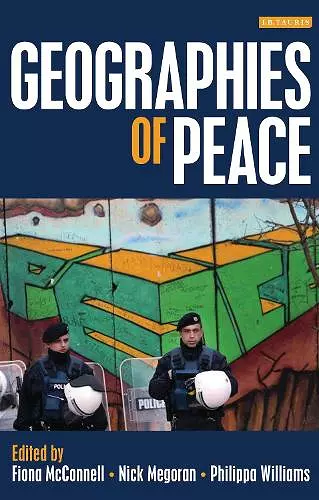Geographies of Peace
New Approaches to Boundaries, Diplomacy and Conflict Resolution
Nick Megoran author Fiona McConnell author Philippa Williams author Nick Megoran editor Fiona McConnell editor
Format:Hardback
Publisher:Bloomsbury Publishing PLC
Published:20th Jun '14
Currently unavailable, and unfortunately no date known when it will be back

From handshakes on the White House lawn to Picasso's iconic dove of peace, the images and stereotypes of peace are powerful, widespread and easily recognizable. Yet if we try to offer a concise definition of peace it is altogether a more complicated exercise. Not only is peace an emotive and value-laden concept, it is also abstract, ambiguous and seemingly inextricably tied to its antithesis: war. And it is war and violence that have been so compellingly studied within critical geography in recent years. This volume offers an attempt to redress that balance, and to think more expansively and critically about what peace means and what geographies of peace may entail. The editors begin with an examination of critical approaches to peace in other disciplines and a helpful genealogy of peace studies within geography. The book is then divided into three sections. The opening section examines how the idea of peace may be variously constructed and interpreted according to different sites and scales. The chapters in the second section explore a remarkably wide range of techniques of peacemaking.This widens the discussion from the archetypical image of top-down, diplomatic state-led initiatives to imperial boundary making practices, grassroots cultural identity assertion, boycotts, self-immolation, ex-paramilitary community activism, and 'protective accompaniment'.
The final section shifts the scale and focus to everyday personal relations and a range of practices around the concept of coexistence. In their concluding chapter the editors spell out some of the key questions that they believe a geography of peace must address: What spatial factors have facilitated the success or precipitated the failure of some peace movements or diplomatic negotiations? Why are some ideologies productive of violence in some places but co-operation in others? How have some communities been better able to deal with religious, racial, cultural and class conflict than others? How have creative approaches to sharing sovereignty mitigated or transformed territorial disputes that once seemed intractable? Geographies of Peace is the first book wholly devoted to exploring the geography of peace.Drawing on both recent advances in social and political theory and detailed empirical research covering four continents, it makes a significant intervention into current debates about peace and violence.
'Rich and incisive, these essays offer a number of different significant perspectives - What emerges very strongly - is how important spatial practices are for the interpretation of peace: what looks like peacemaking from one position and scale is much more problematic from other perspectives historical, institutional, state, spatial, political and economic, social, everyday, cultural and so on. This suggests the need for a far more diverse consideration of the dimensions of peace. With this volume, geography is more fully returned - to an eirenist modus operandi rather than as gathered within a framework that provides support for war, interests, domination, or instrumentalisation.' From the Foreword by Oliver Richmond
ISBN: 9781780761435
Dimensions: 236mm x 160mm x 32mm
Weight: 660g
320 pages